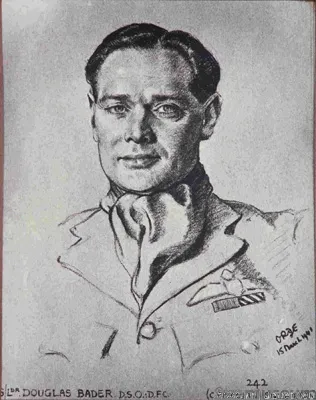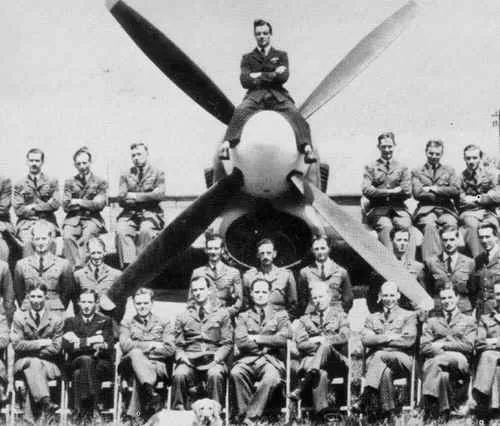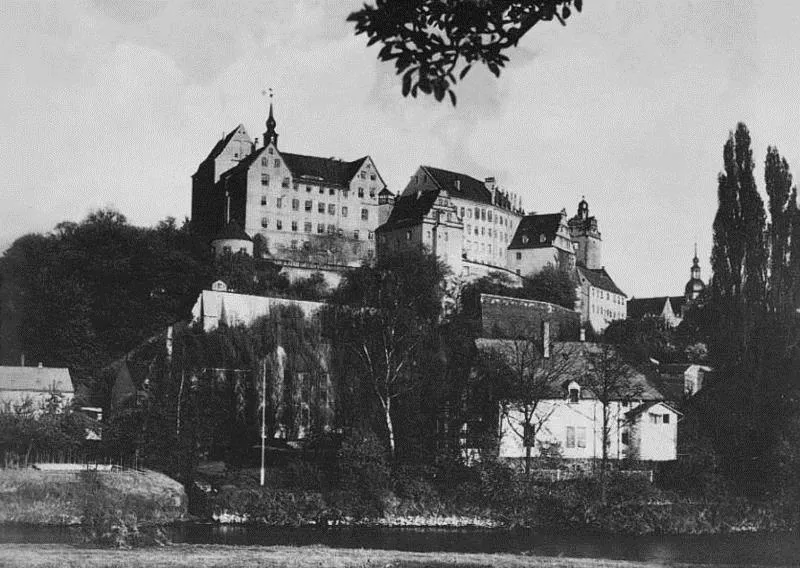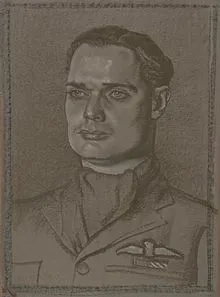GPCAPT Sir Douglas R. S. Bader
Knight Bachelor, CBE, DFC With Bar, DSO With Bar, MiD
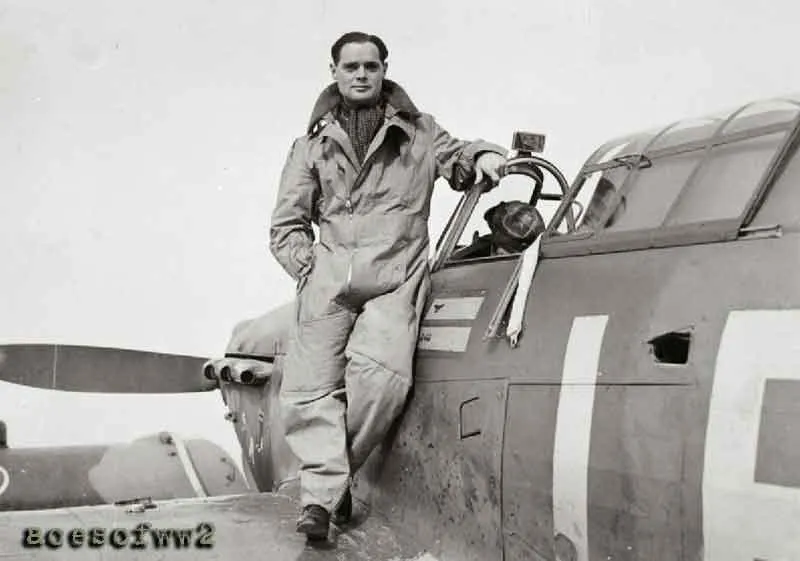


| Squadron/s | 242 SQN RAF |
| Rank On Discharge/Death | Group Captain (GPCAPT) |
| Callsign | Dogsbody |
| Date of Birth | 21 Feb 1910 |
| Date of Death | 05 Sep 1982 |
| Contributing Author/s | From the Spitfire Association's magazine, "The Spitfire News", by Bruce Read. Courtesy of Wikipedia. |
An article from the Spitfire Association's magazine, "The Spitfire News", by Bruce Read. Courtesy of Wikipedia.
His formal title is Group Captain Sir Douglas Bader CBE, DSO and Bar, DFC and Bar, FRAeS, DL RAF (21-02-1910 – 05-09-1982). He was a successful fighter pilot with the Royal Air Force in the Second World War.
Bader is upheld as an inspirational leader and hero not least because he fought despite having lost both legs in a pre-war flying accident. His brutally forthright, dogmatic and often highly opinionated views (especially against authority) coupled with his boundless energy and enthusiasm inspired adoration and frustration in equal measures with both his subordinates and peers.
He went to Temple Grove Prep School, near Crowsborough then to St Edward's School, Oxford, which was also attended by Guy Gibson of Dambusters fame.
Bader joined the RAF as a Cranwel cadet in 1928. He was an above-average pilot and an outstanding sportsman, coming close to national team selection in rugby. Commissioned as a pilot officer in 1930,
On 14 December, 1941, while visiting Reading Aero Club, he attempted some low-flying aerobatics at Woodley airfield in a Bulldog, apparently on a dare. His plane crashed when the tip of the left wing touched the ground. Bader was rushed to the Royal Berkshire Hospital in Reading, where, in the hands of the prominent surgeon Leonard Joyce, both his legs were amputated – one above and one below the knee. Bader made the following laconic entry in his logbook after the crash: "Crashed slow-rolling near ground. Bad show."
In 1932, after a long convalescence Bader was transferred to the hospital at RAF Uxbridge with a new pair of artificial legs. In time, his efforts to regain as much of his abilities as possible paid off and was able to drive a specially modified car play golf, and even dance.
When war broke out in 1939, Bader used his RAF Cranwell connections to rejoin the RAF, despite his disability and reticence on the part of the establishment. His persistence in trying to regain a medical categorisation for operational flying finally succeeded.
Bader's first operational posting was in February 1940 and it was then that he got his first glimpse of a Spitfire. At 29 years of age, Bader was considerably older than his fellow pilots.
In April he was posted to Duxford, it was during this phase of Bader's flying career that he had his first taste of combat. Whilst patrolling the coast near Dunkirk in his Spitfire at around 30,000 feet, he came across a Me 109 in front of him, flying in the same direction and at approximately the same speed. Bader believed that the German must have been a novice, taking no evasive action even though it took more than one burst of gunfire to shoot him down. His second encounter was with a Dornier a day or two later, in which he narrowly avoided a collision whilst silencing the aircraft's rear-gunner during a high-speed pass.
After flying operations over Dunkirk, he was posted to command No. 242 squadron as Squadron Leader at the end of June 1940; a Hurricane unit mainly made up of Canadians who had suffered high losses in the Battle of France and were low on morale. Despite initial resistance to their new commanding officer, the pilots were soon won over by Bader's strong personality and perseverance, especially in cutting through red tape to make the squadron operational again. Upon the formation of 12 Group, no. 242 squadron was assigned to it while it was based at Duxford.
As the Battle of Britain progressed, Bader often found himself at the head of a composite wing of fighters consisting of up to five squadrons. Achievements of the Big Wing were hard to quantify, as the large formations often over claimed aircraft shot down.
In 1941 Bader was promoted to Wing Commander and become one of the first ‘Wing Leaders'. Stationed at Tangmere, Bader led his wing of Spitfires on sweeps and "circus' operations over northwestern Europe throughout the summer campaign. These were missions combining bombers and fighters designed to lure out and tie down German Luftwaffe fighter units that might otherwise serve on the Russian front.
One of the Wing Leader's ‘perks' was permission to have their initials marked on their aircraft as personal identification, thus ‘ D-B ‘ was painted on the side of Bader's Spitfire. These letters gave rise to his radio call sign "Dogsbody."
By August 1941, Bader had claimed 22 German planes shot down, the fifth highest total in the RAF. On 19 August, 1941 Bader was shot down and taken prisoner. As he tried to bail out, one of his prosthetic legs became trapped in the aircraft, and he only escaped when the leg's retaining straps broke.
Bader was captured by German forces, who treated him with great respect. General Adolf Galland, a German flying ace, notified the British of his damaged leg and offered them safe passage to drop off a replacement. The British responded on 19 August, 1941 with the ‘Leg Operation'- an RAF bomber was allowed to drop a new prosthetic leg by parachute. The Germans were less impressed when, task done, the bombers proceeded onto their bombing mission to Gosnay power station near Bethune, although bad weather prevented the target being attacked.
Bader tried to escape from the hospital where he was recovering, and over the next few years proved as big a thorn in the side of the Germans as he had been to the RAF establishment.
He made so many attempts at escape that the Germans threatened to take away his legs. Initially held at, his ‘goon-baiting' of the camp guards reached such heights that he was finally dispatched to the "escape-proof" Colditz Castle, where he remained until the spring of 1945 when it was relieved by the 1st US Army. When Bader subsequently arrived in Paris, true to form, he requested a Spitfire so that he could rejoin the fighting before the war was over, only to be refused.
After returning to England, Bader stayed in the Air Force until February 1946. In June 1945, he was given the honour of leading a victory fly-past of 300 aircraft over London. He left to take a job at Royal Dutch/Shell resumed playing golf, an enthusiasm developed after his amputation, achieving a handicap in the low single figures.
In 1976 Bader was knighted for his services to amputees and his public work for the disabled. His workload was exhausting for a legless man with a worsening heart condition, and Bader died of a heart attack on 5 September 1982 at the age of 72, after a London Guildhall dinner honouring the 90th birthday of the Marshal of the Royal Air Force, Sir Arthur "Bomber" Harris.
Bader's artificial legs are on display at the RAF Museum at Stafford, although this is not a museum that is open to the public.
